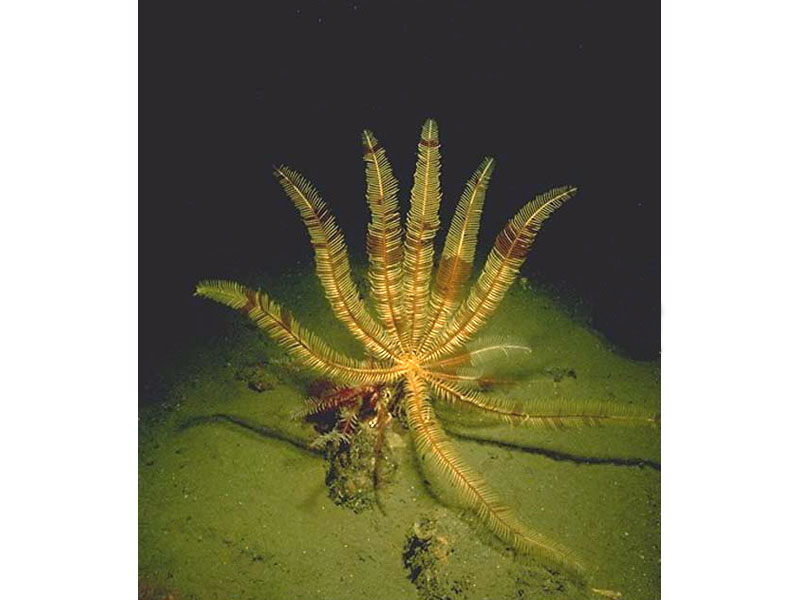Northern feather star (Leptometra celtica)
Distribution data supplied by the Ocean Biodiversity Information System (OBIS). To interrogate UK data visit the NBN Atlas.Map Help
| Researched by | Sonia Rowley | Refereed by | Admin |
| Authority | (M'Andrew & Barrett, 1857) | ||
| Other common names | - | Synonyms | - |
Summary
Description
Each of the northern feather stars ten arms has numerous neat side branches giving the appearance of a feather. Its arms are 7-15 cm long and may be brown, yellow, white, pinky-red, or banded red and white. Like starfish, the arms are connected to a central disc. Beneath the central disc, feather stars have slender and pure white hair-like legs, each with 40-50 joints, used for crawling or holding on to the substratum. The cirral joints close to the underside of the central disc (the centrodorsal plate) are twice as long as they are broad, whereas those further away are as long as they are broad. This and the far dorsal edge being slightly swollen, gives the cirri a slightly scalloped appearance. Feather stars can be seen to spread its arms out in vertical fan to catch food in passing currents.
Recorded distribution in Britain and Ireland
Recorded from the continental shelf to west and south west of Britain and the west Scottish sea lochs.Global distribution
-Habitat
This species can be found on shell gravel from 40 to over 1000 m depth. It has also been recorded at 20 m in the Scottish sea lochs and sheltered conditions.Depth range
-Identifying features
- 10 slender pinate arms up to 15 cm long.
- Conical or hemispherical centrodorsal plate.
- Up to 45 slender, white cirri with 40-50 segments.
- Arms may be banded red and white or plain brown, yellow, white or pinky-red.
Additional information
Leptometra celtica may be mistaken for Antedon bifida or Antedon petasus. Individuals have been observed to spread out their arms into a vertical fan across the current when in areas of moderate water flow. Antedon present at the same site was not observed to show this behaviour (Picton, 1993). Two annelid species of the genus Myzostoma have been associated with the arms and disc of this species (Southward & Campbell, 2006).
Listed by
Bibliography
Costello, M.J., Bouchet, P., Boxshall, G., Emblow, C. & Vanden Berghe, E., 2004. European Register of Marine Species [On-line]. http://www.marbef.org/data/erms.php,
Howson, C.M. & Picton, B.E., 1997. The species directory of the marine fauna and flora of the British Isles and surrounding seas. Belfast: Ulster Museum. [Ulster Museum publication, no. 276.]
Kelly, M.S. & McKenzie, J.D., 1995. A survey of the occurrence and morphology of sub-cuticular bacteria in shelf echinoderms from the north-east Atlantic. Marine Biology, 123, 741-756.
Mortensen, T.H., 1927. Handbook of the echinoderms of the British Isles. London: Humphrey Milford, Oxford University Press.
Picton, B.E., 1993. A field guide to the shallow-water echinoderms of the British Isles. London: Immel Publishing Ltd.
Roberts, J.M., Brown, C.J., Long, D. & Bates.C.R. 2005. Acoustic mapping using a multibeam echosounder reveals cold-water coral reefs and surrounding habitats. Coral Reefs, 24, 654-669.
Southward, E.C. & Campbell, A.C., 2006. Echinoderms. The Linnean Society of London. Avon: The Bath Press. [Synopses of the British Fauna No. 56.]
Datasets
NBN (National Biodiversity Network) Atlas. Available from: https://www.nbnatlas.org.
OBIS (Ocean Biodiversity Information System), 2025. Global map of species distribution using gridded data. Available from: Ocean Biogeographic Information System. www.iobis.org. Accessed: 2025-07-21
Citation
This review can be cited as:
Last Updated: 25/01/2007



